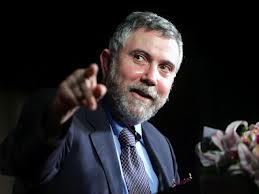The United States is often seen as the heart of global capitalism – a dog-eat-dog system of ruthless market forces where the winner takes all. Europe, on the other hand, is viewed as much more humane – "Socialist" – where the state intervenes to protect the citizens from the extreme consequences of market capitalism.
If we look at the recovery from the economic meltdoen of 2007 – 2010, however, the roles are pretty much reversed:
Spätestens seit der Finanz- und Wirtschaftskrise ab 2007 hat sich die Rolle der beiden Regionen gewandelt: Die USA verabschiedeten Konjunkturprogramme und unterstützen über ihre Notenbank Banken und Wirtschaft. Auch wenn in den USA nicht alles das Gelbe vom Ei ist (vor allem bezogen auf Armut und die ungleiche Verteilung), wächst die amerikanische Wirtschaft seit 2008 langsam aus der Krise, und die Arbeitslosigkeit fällt – langsam, aber doch. … In Europa hingegen führte eine völlig verkehrte Reaktion auf die Krise, zuerst der Europäischen Zentralbank und dann der Regierungen (Stichworte: Zinserhöhungen und Austerität), zu Massenarbeitslosigkeit, Armut und einer sozialen Notsituation. Die Arbeitslosenquote in der Eurozone ist von sieben Prozent der Erwerbspersonen vor der Krise auf zehn Prozent im Jahr 2010 und dann weiter auf zwölf Prozent im Jahr 2013 gestiegen.
(The roles of the two regions have switched at least since the financial economic crisis of 2007: the US passed stimulus programs through the Federal Reserve Bank which supported the banks and the economy. And even though the picture in the US is not all that rosy (especially in view of the poverty and economic inequality) the American economy has been slowly growing out of the crisis, and unemployment is falling – slowly but steadily. Europe, on the other hand, has addressed the crisis in a completely opposite way, beginning with the European Central Bank and then by the governments (think of raising interest rates and imposing austerity)., which has let to mass unemployment, poverty and social crisis. The unemployment rate in the Eurozone has climbed from 7% before the crisis, to 10% in 2010 and then to 12% in 2013).)
The author of the article points to the influencial eocnomists such as Paul Krugman, Joseph Stieglitz, Christina Romer, and Oliver Blanchard at the IMF who learned the lessons from the Great Depression of the 1930s and pushed for government stimulus despite fierce opposition primarily from Republicans in the US Congress.
In Europe, however, neo-liberal dogma prevais:
In Europa ist die Situation diametral entgegengesetzt. Im ganzen deutschsprachigen Raum etwa gibt es kaum mehr keynesianische Lehrkräfte an den Universitäten – nicht einmal solche, die durch die Krise bekehrt wurden. Nach einer Schrecksekunde war daher die wirtschaftspolitische Debatte in Europa neoliberal: Schulden und Defizite müssen hinunter, Löhne für die Wettbewerbsfähigkeit gesenkt werden. Damit verschlimmerte die Politik die private Nachfrageschwäche mit einer öffentlichen Nachfrageschwäche: Europa spart sich in eine zweite Weltwirtschaftskrise. Die wirtschaftliche Entwicklung ist in Europa heute genauso schwach wie zum gleichen Zeitpunkt in der Krise der 1930er-Jahre.
(In Europe the situation is the exact opposite. In the entire German-speaking region there are hardly any Keynesians teaching at the universities – not even some who might have been converted by the crisis. After the shock the economic debate in Europe was neo-liberal: debt and deficits had to come down, wages for workers needed to be lower. Demand in the public sector was drastically cut which only weakened the private sector even more: Europe is saving itself into a second global economic crisis. The economic development today in Europe is just as weak as it was at the same point during the crisis in the 1930s.)
Of course, if you follow Krugman and Stiglitz, they argue today that the federal government is not doing nearly as much as it should to stimulate the economy. But if the US has followed the European course, things would be much worse here today.



1 comment
I wonder what the FED (or the government) could do if they had to face a new surprise economic disaster like a crash on Wall Street, for whatever reason. Offer negative interest rates? Still, the dogma is printing money and buying bonds won’t cause deflation – and calling this the mother of all bubbles almost equals lese-majeste.
Buy some silver in time and a gun and be prepared for a new Emergency Banking Act like that on April 5th 1933…